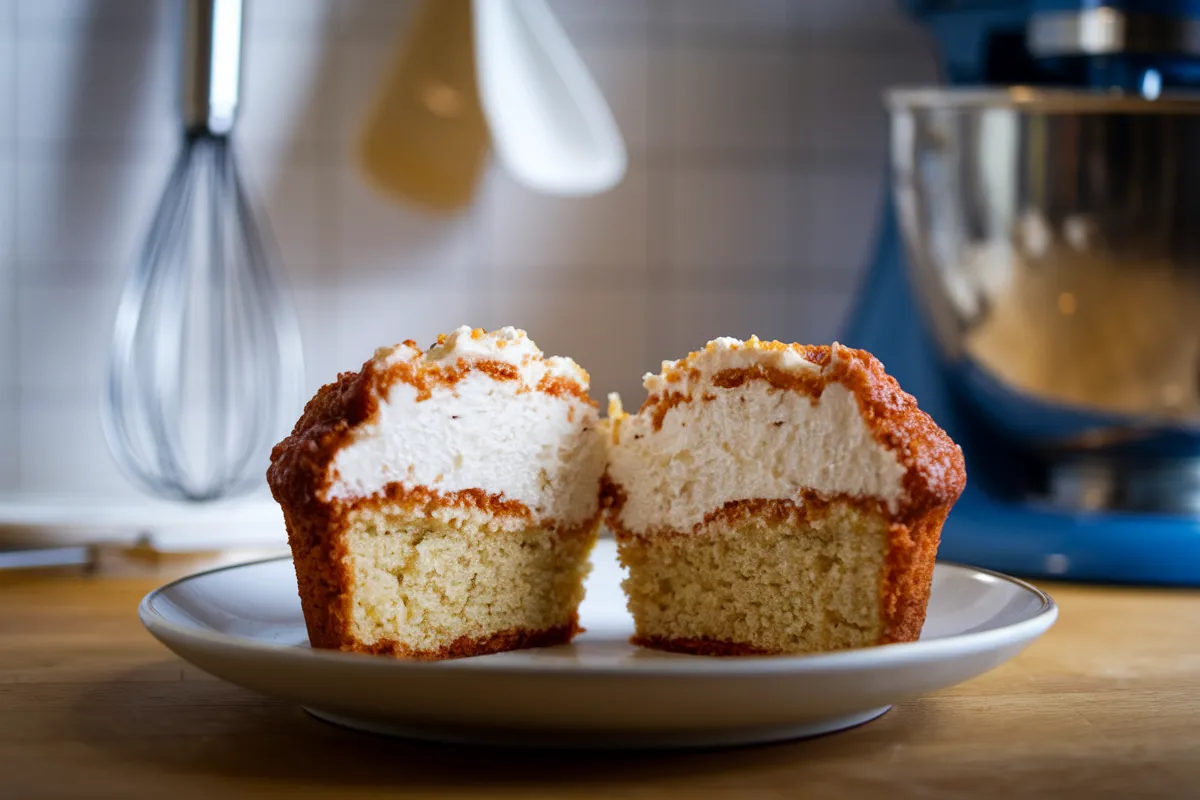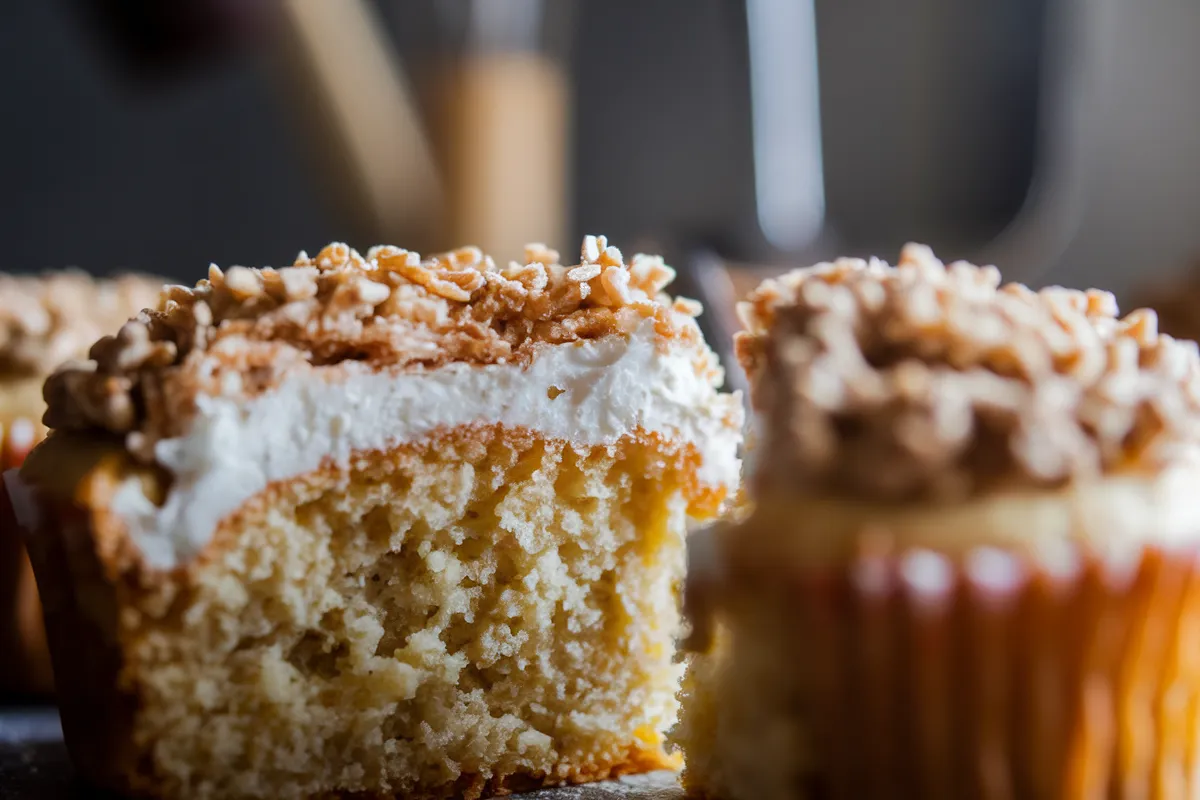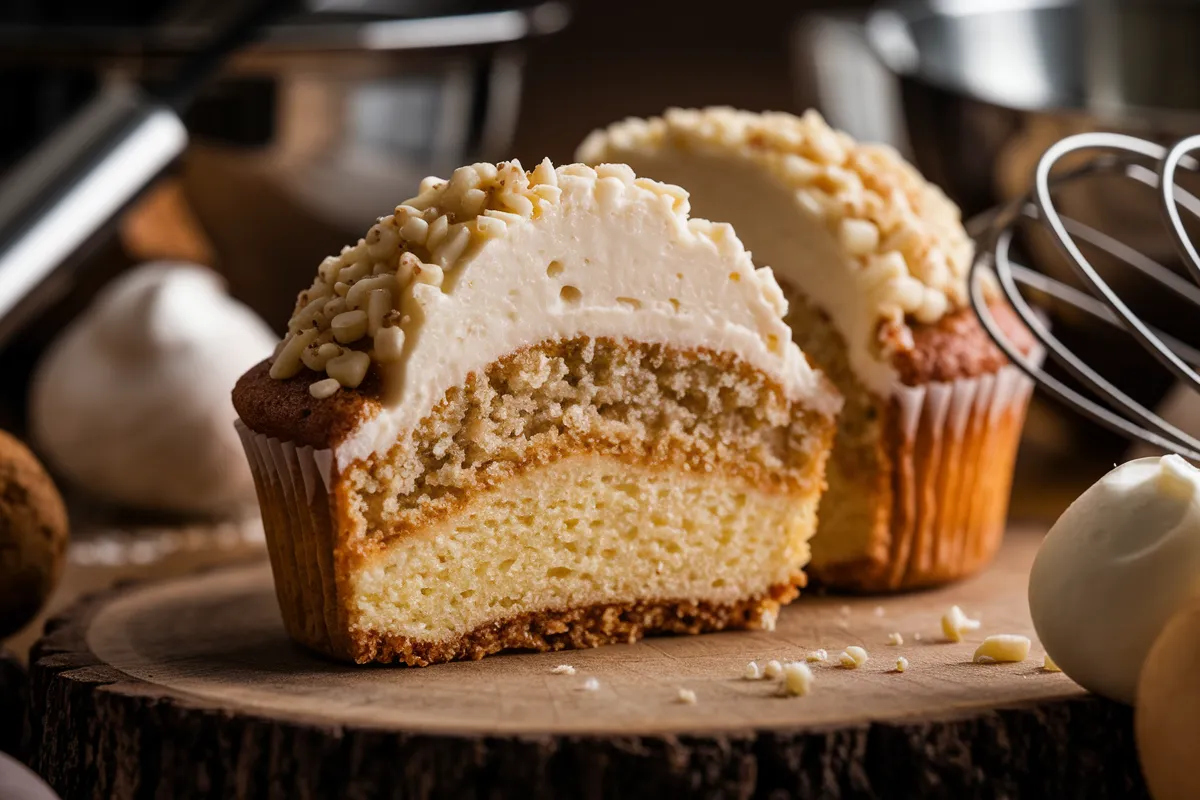Cupcakes are meant to be light, fluffy, and moist, with a soft crumb and a delicate, tender texture. However, nothing is more disappointing than biting into a cupcake that’s unexpectedly crunchy. A crunchy cupcake is not only frustrating, but it also indicates that something went wrong during the baking process. Whether you’re a novice or an experienced baker, understanding why cupcakes turn crunchy can help you avoid this problem in the future.
This comprehensive guide will walk you through the most common reasons for crunchy cupcakes, offer tips to fix the issue, and help you achieve perfectly soft cupcakes every time. We’ll also delve into specific ingredients, baking techniques, and troubleshooting strategies to ensure your cupcakes come out flawless.
Table of Contents
- What Causes Crunchy Cupcakes?
- 1.1. Too Much Sugar
- 1.2. Overbaking
- 1.3. Incorrect Oven Temperature
- 1.4. Overmixing the Batter
- How to Prevent Crunchy Cupcakes
- 2.1. Measure Ingredients Accurately
- 2.2. Don’t Overbake
- 2.3. Use the Right Oven Temperature
- 2.4. Mix the Batter Gently
- 2.5. Avoid Adding Extra Sugar
- 2.6. Proper Storage to Prevent Crunchiness
- Common Mistakes That Lead to Crunchy Cupcakes
- 3.1. Using the Wrong Type of Flour
- 3.2. Baking at the Wrong Rack Position
- 3.3. Using Old Ingredients
- 3.4. Overfilling the Cupcake Liners
- Tips for Perfect Cupcakes Every Time
- 4.1. Sift Your Dry Ingredients
- 4.2. Use Room Temperature Ingredients
- 4.3. Use Cupcake Liners
- 4.4. Don’t Open the Oven Door Too Early
- Frequently Asked Questions (FAQs) About Crunchy Cupcakes
- 5.1. Why are my cupcakes crunchy on top but soft inside?
- 5.2. Can I save crunchy cupcakes?
- 5.3. How can I avoid cupcakes getting crunchy when stored?
- Conclusion
1. What Causes Crunchy Cupcakes?
Several factors can contribute to the unwanted crunchiness in cupcakes. It could be due to incorrect ingredient measurements, overmixing the batter, baking time, or even issues with your oven temperature. Let’s explore each of these factors in detail to determine what might be causing your cupcakes to develop a crunchy texture.
1.1. Too Much Sugar
One of the most common causes of crunchy cupcakes is an excessive amount of sugar. When there’s too much sugar in the batter, it can crystallize during baking, creating a crunchy texture, especially around the edges and top of the cupcakes. Sugar naturally caramelizes and hardens when heated, which can result in a harder, crunchier cupcake instead of the soft, tender crumb you’re aiming for.
To avoid this, make sure to follow the recipe’s sugar measurements accurately. If you’re experimenting with your recipe, try reducing the sugar by a few tablespoons to see if it improves the texture.
1.2. Overbaking
Overbaking cupcakes is another major contributor to unwanted crunchiness. When cupcakes are left in the oven too long, the moisture evaporates, leaving them dry and potentially hard around the edges. The cupcakes may also develop a crunchy or crusty top that is difficult to bite through.
To prevent overbaking, it’s important to keep a close eye on the baking time. Cupcakes typically bake for about 18-22 minutes at 350°F (175°C), but the exact time can vary depending on your oven and the size of your cupcakes. Start checking for doneness around the 15-minute mark by inserting a toothpick into the center. If it comes out clean or with a few moist crumbs, your cupcakes are ready to come out of the oven.
1.3. Incorrect Oven Temperature
Oven temperature plays a significant role in how your cupcakes bake. If your oven runs hotter than the recipe specifies, the outer edges of the cupcakes can bake too quickly, leading to a crunchy or hard texture. To avoid this, use an oven thermometer to ensure your oven is at the correct temperature. Adjust the temperature as needed to match the recipe’s instructions.
1.4. Overmixing the Batter
When cupcake batter is overmixed, it can lead to the formation of gluten, which creates a denser, chewier, and sometimes crunchy texture. Overmixing also incorporates too much air, causing the cupcakes to rise too quickly and then collapse, leading to a denser and possibly crunchier top. Mix the batter just until the ingredients are combined, and avoid overbeating to maintain a soft texture.
2. How to Prevent Crunchy Cupcakes
Now that we’ve explored the common causes of crunchy cupcakes, let’s focus on how to prevent these issues and ensure you get soft, fluffy cupcakes every time. By paying close attention to ingredients, baking techniques, and oven settings, you can avoid the common pitfalls that lead to crunchy cupcakes.
2.1. Measure Ingredients Accurately
Baking is a science, and precise measurements are crucial for achieving the desired texture in your cupcakes. When measuring ingredients, especially sugar, flour, and baking powder, use the following tips:
- Use a digital scale: Weighing your ingredients is the most accurate way to measure, ensuring you’re not using too much or too little of any ingredient.
- Spoon and level method: If you’re using measuring cups, use the spoon and level method for flour. Spoon the flour into the cup and level it off with a flat edge to avoid packing the flour, which can result in dense or crunchy cupcakes.
- Check sugar measurements: Make sure you’re not adding extra sugar to your batter, as this can crystallize and lead to a crunchy texture.
2.2. Don’t Overbake
As mentioned earlier, overbaking can dry out your cupcakes and cause them to develop a crunchy top. Here’s how to avoid overbaking:
- Check early: Start checking your cupcakes for doneness about 3-5 minutes before the recommended baking time. Insert a toothpick or cake tester into the center of a cupcake to check for doneness. If it comes out clean or with a few moist crumbs, they’re ready to be removed from the oven.
- Rotate the pans: Halfway through baking, rotate the cupcake pans to ensure even baking. Some ovens have hot spots that can cause certain areas to bake faster than others, leading to crunchy or burnt edges.
2.3. Use the Right Oven Temperature
Incorrect oven temperature is another culprit behind crunchy cupcakes. If your oven is too hot, the cupcakes may rise too quickly, causing them to develop a hard or crunchy exterior. Here’s how to ensure your oven is at the correct temperature:
- Preheat your oven: Always preheat your oven for at least 10-15 minutes before baking. This ensures that the oven is at a stable temperature when you place the cupcakes inside.
- Use an oven thermometer: Ovens can be inaccurate, and the temperature setting on your oven may not always match the actual temperature inside. An oven thermometer will help you verify that your oven is heating properly.
2.4. Mix the Batter Gently
Overmixing the batter can lead to gluten development, resulting in dense, tough, and potentially crunchy cupcakes. To avoid overmixing:
- Mix until combined: When adding the dry ingredients to the wet ingredients, mix just until the ingredients are combined. A few small lumps in the batter are okay, and they will bake out during the cooking process.
- Use a spatula or low-speed mixer: If you’re using an electric mixer, keep it on low speed to avoid overmixing. Alternatively, use a spatula to fold the ingredients together gently.
2.5. Avoid Adding Extra Sugar
While sugar is essential for flavor and moisture in cupcakes, adding too much sugar can result in a crunchy texture, particularly on the edges. Follow these guidelines to avoid over-sweetening your batter:
- Stick to the recipe: Always measure sugar accurately and avoid adding more than the recipe calls for. If you want sweeter cupcakes, consider using flavorful frostings or fillings rather than increasing the sugar in the batter.
- Experiment with brown sugar: If you find that white sugar is creating a crunchy texture, try substituting some of the sugar with brown sugar. Brown sugar has a higher moisture content and may help create a softer, more tender cupcake.
2.6. Proper Storage to Prevent Crunchiness
Storing cupcakes incorrectly can lead to them drying out and becoming crunchy. After baking, ensure your cupcakes stay soft and moist with these tips:
- Cool completely: Allow your cupcakes to cool completely on a wire rack before storing them. Storing warm cupcakes in an airtight container can cause condensation, leading to soggy or overly soft tops, which may develop into crunchy edges when exposed to air.
- Store in an airtight container: Once cooled, store your cupcakes in an airtight container at room temperature. If you plan to store them for more than a day, consider freezing them to maintain their freshness.
- Frosting as a barrier: Adding frosting to your cupcakes can help keep them moist by creating a barrier that locks in moisture. However, be sure to frost them only after they’ve cooled completely.
3. Common Mistakes That Lead to Crunchy Cupcakes
Even experienced bakers can make mistakes that result in crunchy cupcakes. Below are some common baking mistakes that you can avoid to ensure your cupcakes turn out perfectly every time.
3.1. Using the Wrong Type of Flour
The type of flour you use can significantly impact the texture of your cupcakes. All-purpose flour is commonly used in cupcake recipes, but it has a higher protein content than cake flour, which can result in denser, more crumbly cupcakes. Cake flour, on the other hand, has a lower protein content, making it ideal for light, fluffy cupcakes.
If your cupcakes are coming out dense and crunchy, consider switching to cake flour or a blend of cake and all-purpose flour. Cake flour will give your cupcakes a softer texture, while still maintaining the structure needed for a good rise.
3.2. Baking at the Wrong Rack Position
The position of your cupcake pans in the oven can affect how they bake. If you bake your cupcakes too close to the top or bottom of the oven, they may overbrown or develop a crunchy crust before the center is fully baked.
To ensure even baking, always place your cupcake pans in the center of the oven, where the heat is most evenly distributed. Avoid placing pans directly on the top or bottom racks, as this can cause uneven heat distribution and lead to crunchy edges.
3.3. Using Old Ingredients
Using expired or old ingredients, particularly baking powder and baking soda, can affect how your cupcakes rise and bake. If your leavening agents have lost their potency, your cupcakes may not rise properly, resulting in a denser, crunchier texture.
To prevent this, always check the expiration dates on your baking powder and baking soda. These ingredients typically have a shelf life of about 6 months to a year. If you’re unsure whether they’re still active, you can test baking powder by mixing it with a little warm water. If it bubbles vigorously, it’s still good to use. For baking soda, mix it with vinegar to check for bubbling.
3.4. Overfilling the Cupcake Liners
Filling cupcake liners too full can cause the batter to overflow during baking, which can lead to crunchy edges or a hard top. Cupcakes that overflow may also not bake evenly, with the tops becoming hard while the centers remain undercooked.
To avoid this issue, fill your cupcake liners only two-thirds full. This allows the batter enough room to rise without spilling over the edges. If you have extra batter, it’s better to make a few additional cupcakes rather than overfilling the liners.
4. Tips for Perfect Cupcakes Every Time
Now that we’ve covered the potential causes and mistakes that can lead to crunchy cupcakes, here are some tips to help you achieve perfect, soft, and fluffy cupcakes every time.
4.1. Sift Your Dry Ingredients
Sifting your dry ingredients, especially flour, helps to aerate them and remove any lumps. This ensures that the flour is evenly distributed in the batter, which leads to a lighter, more consistent texture. Sifting also helps prevent overmixing by allowing the dry ingredients to blend more easily into the wet ingredients.
4.2. Use Room Temperature Ingredients
Using ingredients at room temperature, particularly butter, eggs, and milk, allows them to incorporate more smoothly into the batter. Cold ingredients can cause the batter to curdle or become lumpy, which can affect the texture of the cupcakes.
Before you start baking, take your ingredients out of the refrigerator and let them come to room temperature for about 30 minutes. Softened butter will cream more easily with sugar, creating a light and fluffy batter that results in tender cupcakes.
4.3. Use Cupcake Liners
Cupcake liners not only make it easier to remove cupcakes from the pan, but they also help prevent the edges of the cupcakes from becoming crunchy. Liners act as a barrier between the batter and the metal pan, allowing the cupcakes to bake more evenly without overbrowning.
If you don’t have cupcake liners, be sure to grease your cupcake pan thoroughly with non-stick spray or butter. This will help prevent the cupcakes from sticking to the pan and reduce the risk of crunchy edges.
4.4. Don’t Open the Oven Door Too Early
Opening the oven door too early in the baking process can cause a sudden drop in temperature, which can negatively affect how your cupcakes rise. If the temperature drops too quickly, the cupcakes may collapse, resulting in a dense and possibly crunchy texture.
Wait until at least two-thirds of the way through the baking time before opening the oven door to check on your cupcakes. When you do check, open the door gently to avoid letting too much heat escape.
5. Frequently Asked Questions (FAQs) About Crunchy Cupcakes
5.1. Why are my cupcakes crunchy on top but soft inside?
Crunchy tops can result from overbaking or baking at too high a temperature. To prevent this, ensure that your oven is set to the correct temperature and that the cupcakes are removed from the oven as soon as they are done. Using too much sugar can also cause the tops to become crunchy as the sugar caramelizes during baking.
5.2. Can I save crunchy cupcakes?
If your cupcakes have turned out crunchy, there are a few ways to salvage them:
- Add frosting: A generous layer of frosting can help mask the crunchy texture and provide extra moisture. The frosting will also soften the cupcake tops slightly.
- Serve with a sauce or dip: You can serve crunchy cupcakes with a side of whipped cream, custard, or chocolate sauce. This adds moisture and complements the flavor of the cupcakes.
5.3. How can I avoid cupcakes getting crunchy when stored?
To prevent cupcakes from becoming crunchy after storage, make sure they are completely cooled before storing them in an airtight container. If storing them for more than a day, consider freezing them to lock in moisture. Avoid refrigerating cupcakes, as this can cause them to dry out and become crunchy.
6. Conclusion
Baking the perfect cupcake requires a combination of precise measurements, proper techniques, and careful attention to baking time and temperature. If your cupcakes are turning out crunchy, it’s often due to overbaking, incorrect sugar levels, or oven temperature issues. By following the tips and solutions outlined in this article, you can troubleshoot your crunchy cupcakes and ensure that they come out soft, fluffy, and delicious every time.
Remember, baking is a learning process, and it’s okay to experiment and make adjustments along the way. With a little practice and attention to detail, you’ll soon be able to bake the perfect batch of cupcakes with ease. Whether you’re making cupcakes for a special occasion or just a treat for yourself, understanding the factors that contribute to texture will help you achieve consistently excellent results.
Now that you know how to avoid crunchy cupcakes, you can confidently bake cupcakes that are soft, tender, and everything a cupcake should be!



